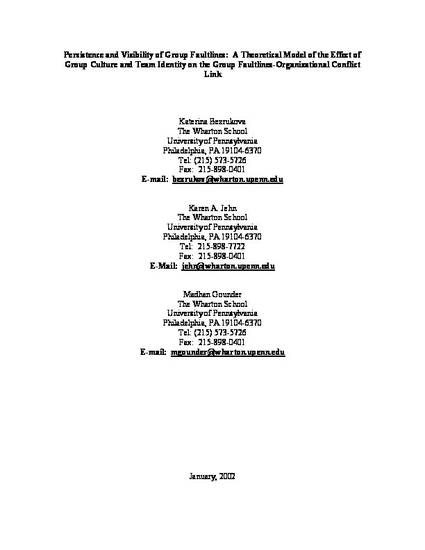
We expand the group faultline theory by taking into account the relative importance of various demographics within the group that can trigger the formation of strong group faultlines. We draw on group faultline theory (Lau & Murnighan, 1998), social identity and categorization theories (Turner & Tajfel, 1986), social dominance theory (Sidanius & Pratto, 1999), and evolutionary psychology (Kurzban & Leary, 2001) to predict how group faultlines affect conflict. We propose that the visible demographic characteristics (age, race, and gender) will be more influential than the non-visible (education, tenure, and function) in determining the interaction patterns within the group (Thatcher & Jehn, 1998). We use the persistence argument from evolutionary psychological theory to further examine the relative importance of the demographics within the subgroups of non-visible and visible characteristics (Kurzban & Leary, 2001). Persistency is defined as the length of time a certain characteristic has been incorporated into society and, based on evolutionary psychology, we propose that gender is more influential than race because gender differences appeared earlier in human society than race differences (Kurzban, Tooby, & Cosmides, 2001). Similarly, we view tenure as more influential than education and function because it can be viewed as a manifestation of experience, which has long been valued in human society. We propose that models where we adjust for the relative influence of demographic characteristics based on our theory will have a better predictive caliber than when all characteristics are weighted equally. We also consider the moderating effects of group culture and team identity on the relationship between group faultlines and conflict. In particular, group culture and team identity will either inflate or deflate the potency of each demographic characteristic on conflict. That is, group faultlines will have less impact on conflict when there is a strong group culture strong team identity. Specifically in this case we examine an organizational culture focused on change.
Available at: http://works.bepress.com/katerina_bezrukova/9/

2002 - The 15th Annual Conference of the IACM, Salt Lake City, Utah, USA Dates: June 9-June 12, 2002 Location: Salt Lake City (Park City), Utah, USA http://www.iacm-conflict.org/